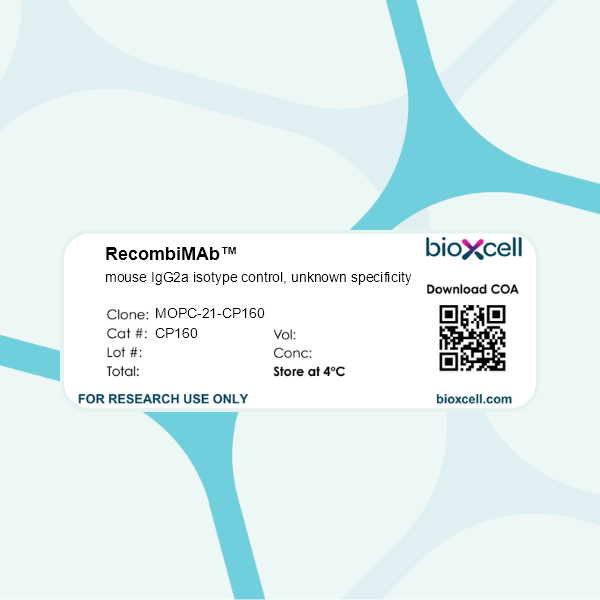RecombiMAb mouse IgG2a isotype control, unknown specificity
(switched from mouse IgG1)
Product Description
Specifications
| Isotype | Mouse IgG2a, κ |
|---|---|
| Recommended Dilution Buffer | InVivoPure pH 7.0 Dilution Buffer |
| Conjugation | This product is unconjugated. Conjugation is available via our Antibody Conjugation Services. |
| Formulation |
PBS, pH 7.0 Contains no stabilizers or preservatives |
| Endotoxin |
≤0.5EU/mg (≤0.0005EU/μg) Determined by LAL assay |
| Aggregation |
<5% Determined by SEC |
| Purity |
≥95% Determined by SDS-PAGE |
| Sterility | 0.2 µm filtration |
| Production | Purified from CHO cell supernatant in an animal free facility |
| Purification | Protein A |
| RRID | AB_2927528 |
| Molecular Weight | 150 kDa |
| Murine Pathogen Tests |
Ectromelia/Mousepox Virus: Negative Hantavirus: Negative K Virus: Negative Lactate Dehydrogenase-Elevating Virus: Negative Lymphocytic Choriomeningitis virus: Negative Mouse Adenovirus: Negative Mouse Cytomegalovirus: Negative Mouse Hepatitis Virus: Negative Mouse Minute Virus: Negative Mouse Norovirus: Negative Mouse Parvovirus: Negative Mouse Rotavirus: Negative Mycoplasma Pulmonis: Negative Pneumonia Virus of Mice: Negative Polyoma Virus: Negative Reovirus Screen: Negative Sendai Virus: Negative Theiler’s Murine Encephalomyelitis: Negative |
| Storage | The antibody solution should be stored at the stock concentration at 4°C. Do not freeze. |
| Need a Custom Formulation? | See All Antibody Customization Options |
Product Citations
-
-
Cancer Research
-
Immunology and Microbiology
The Combination of Anti-CD47 Antibody with CTLA4 Blockade Enhances Anti-Tumor Immunity in Non-Small Cell Lung Cancer via Normalization of Tumor Vasculature and Reprogramming of the Immune Microenvironment.
In Cancers (Basel) on 19 February 2024 by Zhuang, Z., Zhou, J., et al.
PubMed
In solid tumors, the formidable anti-tumor impact resulting from blocking the "don't eat me" signal, arising from CD47-SIRPα interaction, is constrained, especially compared to its efficacy in hematopoietic malignancies. Activating macrophage anti-tumor activity not only necessitates the inhibition of the "don't eat me" signal, but also the activation of the "eat me" (pre-phagocyte) signal. Intriguingly, the cytotoxic T-lymphocyte-associated antigen 4 (CTLA4) antibody (Ab) has been identified to stimulate Fc receptor-mediated active phagocytes in the tumor microenvironment, thereby generating "eat me" signals. This study postulates that concurrently targeting CD47 and CTLA4 could intensify the anti-tumor effects by simultaneously blocking the "don't eat me" signal while triggering the "eat me" signal. The experimental data from this investigation confirm that the combined targeting of CD47 and CTLA4 enhances immunity against solid tumors in LLC cell-transplanted tumor-bearing mice. This effect is achieved by reducing myeloid-derived suppressor cell infiltration while increasing the presence of effector memory CD8+ T cells, NK1.1+ CD8+ T cells, and activated natural killer T cells. Meanwhile, combination therapy also alleviated anemia. Mechanistically, the anti-CD47 Ab is shown to upregulate CTLA4 levels in NSCLC cells by regulating Foxp1. Furthermore, targeting CD47 is demonstrated to promote tumor vascular normalization through the heightened infiltration of CD4+ T cells. These findings suggest that the dual targeting of CD47 and CTLA4 exerts anti-tumor effects by orchestrating the "eat me" and "don't eat me" signals, reshaping the immune microenvironment, and fostering tumor vascular normalization. This combined therapeutic approach emerges as a potent strategy for effectively treating solid tumors.
-

